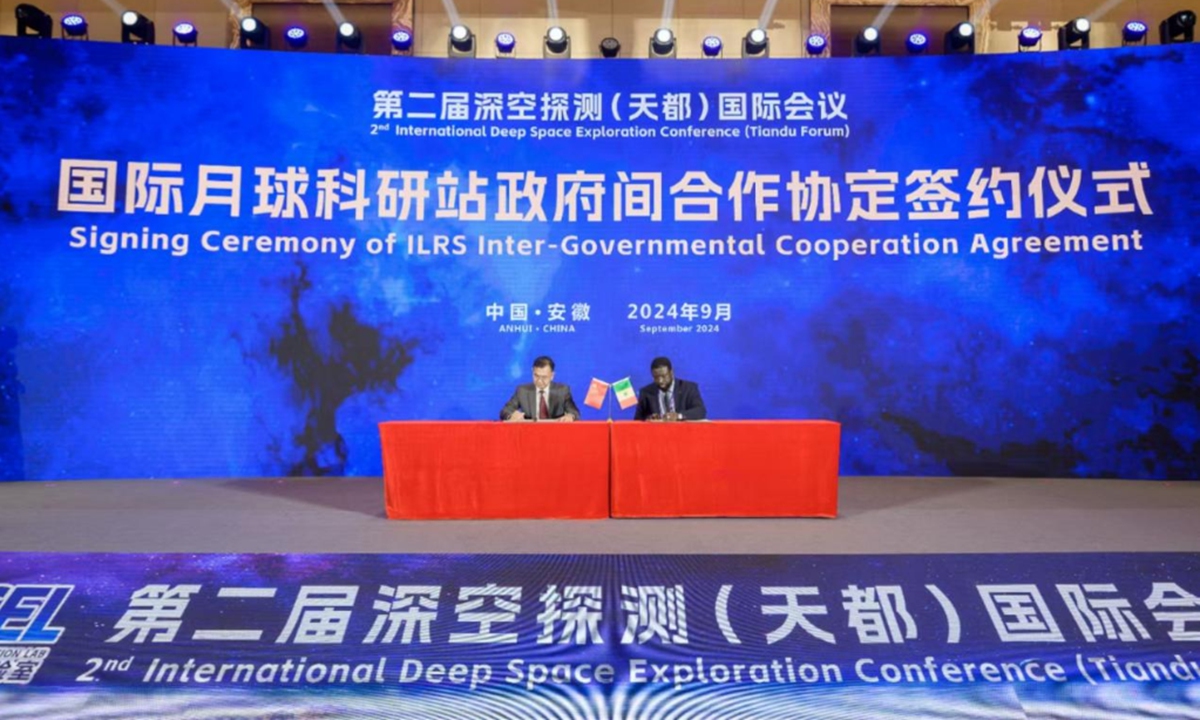
A signing ceremony is held during the 2nd International Deep Space Exploration Conference on September 5, 2024. Photo from web
In the latest efforts to advance South-South cooperation in aerospace, China and Africa have agreed to deepen collaboration in deep-space exploration amid the ongoing 2024 Summit of the Forum on China-Africa Cooperation (FOCAC). On Thursday, Senegal, along with several African institutions, announced their participation in the China-led International Lunar Research Station (ILRS) program, bringing the total number of participants in the program to more than 10 countries and over 40 international organizations worldwide.
Li Guoping, China National Space Administration's (CNSA) chief engineer, signed an agreement with Maram Kaïré, Director General of the Senegalese Space Studies Agency, to engage in cooperation on the ILRS project during the 2nd International Conference on Deep Space Exploration on Thursday, media reported.
In addition to Senegal, CNSA signed Memoranda of Understanding (MOUs) with 10 international organizations at the event, including institutions from Serbia, Switzerland, the UAE, Panama, Indonesia, Pakistan, and South Africa, in addition to the Belt and Road Alliance for Science & Technology, the Foundation for Space Development Africa, and the Africa Business Alliance.
The new partnership has added to international organizations aboard the ILRS since China's initial call for international partners in 2017. To date, Venezuela, Belarus, Pakistan, Azerbaijan, South Africa, Egypt, Nicaragua, Thailand, Serbia and Kazakhstan have joined China and Russia as part of the venture.
Wu Yanhua, chief designer of the country's major deep space exploration project, proposed six major cooperation initiatives for the ILRS at the Thursday event, encouraging global partners to join at various stages of the project.
These initiatives cover cooperation in areas including joint demonstrations, mission-level collaboration, system development, ground facilities, scientific research, and education. China also announced plans to establish an international cooperation committee and headquarters to foster a supportive environment for partners, Wu said.
The ILRS is a scientific experimental facility consisting of sections on the lunar surface, in lunar orbit and on Earth. It is designed to be a long-term, autonomous, expandable scientific research station that can support human missions for short durations.
Wu also mentioned at the conference that this lunar facility would provide a wide range of functionalities, including power supply, central command, communication and navigation, Earth-Moon transportation, lunar exploration, and ground support.
China plans to launch three Chang'e lunar probe missions within the next four years, with the goal of completing the basic version of the ILRS by 2035, authorities revealed at a 2024 China Space Conference held in April.
By 2035, the basic version will be centered around the lunar south pole, with comprehensive scientific facilities equipped with basic functions and elements, conducting regular scientific experiments.
By 2045, the expanded version will be completed, with the lunar orbit station as the hub, featuring fully equipped and substantially scaled facilities, stable operations, while conducting comprehensive scientific research on the moon and in-depth resource development and utilization, in addition to conducting technical verification and scientific experiments related to a manned mission to Mars.
Global Times




